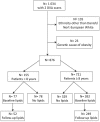Childhood obesity treatment; Effects on BMI SDS, body composition, and fasting plasma lipid concentrations
- PMID: 29444114
- PMCID: PMC5812566
- DOI: 10.1371/journal.pone.0190576
Childhood obesity treatment; Effects on BMI SDS, body composition, and fasting plasma lipid concentrations
Abstract
Objective: The body mass index (BMI) standard deviation score (SDS) may not adequately reflect changes in fat mass during childhood obesity treatment. This study aimed to investigate associations between BMI SDS, body composition, and fasting plasma lipid concentrations at baseline and during childhood obesity treatment.
Methods: 876 children and adolescents (498 girls) with overweight/obesity, median age 11.2 years (range 1.6-21.7), and median BMI SDS 2.8 (range 1.3-5.7) were enrolled in a multidisciplinary outpatient treatment program and followed for a median of 1.8 years (range 0.4-7.4). Height and weight, body composition measured by dual-energy X-ray absorptiometry, and fasting plasma lipid concentrations were assessed at baseline and at follow-up. Lipid concentrations (total cholesterol (TC), low-density lipoprotein (LDL), high-density lipoprotein (HDL), non-HDL, and triglycerides (TG)) were available in 469 individuals (264 girls). Linear regressions were performed to investigate the associations between BMI SDS, body composition indices, and lipid concentrations.
Results: At baseline, BMI SDS was negatively associated with concentrations of HDL (p = 6.7*10-4) and positively with TG (p = 9.7*10-6). Reductions in BMI SDS were associated with reductions in total body fat percentage (p<2*10-16) and percent truncal body fat (p<2*10-16). Furthermore, reductions in BMI SDS were associated with improvements in concentrations of TC, LDL, HDL, non-HDL, LDL/HDL-ratio, and TG (all p <0.0001). Changes in body fat percentage seemed to mediate the changes in plasma concentrations of TC, LDL, and non-HDL, but could not alone explain the changes in HDL, LDL/HDL-ratio or TG. Among 81 individuals with available lipid concentrations, who increased their BMI SDS, 61% improved their body composition, and 80% improved their lipid concentrations.
Conclusion: Reductions in the degree of obesity during multidisciplinary childhood obesity treatment are accompanied by improvements in body composition and fasting plasma lipid concentrations. Even in individuals increasing their BMI SDS, body composition and lipid concentrations may improve.
Conflict of interest statement
Figures



Similar articles
-
Changes in lipidemia during chronic care treatment of childhood obesity.Child Obes. 2012 Dec;8(6):533-41. doi: 10.1089/chi.2011.0098. Child Obes. 2012. PMID: 23181919
-
What reduction in BMI SDS is required in obese adolescents to improve body composition and cardiometabolic health?Arch Dis Child. 2010 Apr;95(4):256-61. doi: 10.1136/adc.2009.165340. Epub 2009 Dec 4. Arch Dis Child. 2010. PMID: 19966092 Clinical Trial.
-
Changes in lipid indices and body composition one year after laparoscopic gastrectomy: a prospective study.Lipids Health Dis. 2018 May 11;17(1):113. doi: 10.1186/s12944-018-0729-1. Lipids Health Dis. 2018. PMID: 29751766 Free PMC article.
-
[Simple obesity in children. A study on the role of nutritional factors].Med Wieku Rozwoj. 2006 Jan-Mar;10(1):3-191. Med Wieku Rozwoj. 2006. PMID: 16733288 Review. Polish.
-
Change in obesity-related metabolic abnormalities associated with body mass index improvement through life-style intervention: A meta-regression.Pediatr Diabetes. 2020 Mar;21(2):173-193. doi: 10.1111/pedi.12955. Epub 2019 Dec 27. Pediatr Diabetes. 2020. PMID: 31820534
Cited by
-
Obesity measured as percent body fat, relationship with body mass index, and percentile curves for Mexican pediatric population.PLoS One. 2019 Feb 25;14(2):e0212792. doi: 10.1371/journal.pone.0212792. eCollection 2019. PLoS One. 2019. PMID: 30802270 Free PMC article. Clinical Trial.
-
Effects of 12 Weeks of Family and Individual Multi-Disciplinary Intervention in Overweight and Obese Adolescents under Cardiometabolic Risk Parameters: A Clinical Trial.Int J Environ Res Public Health. 2023 Oct 20;20(20):6954. doi: 10.3390/ijerph20206954. Int J Environ Res Public Health. 2023. PMID: 37887692 Free PMC article. Clinical Trial.
-
Factors associated with blood pressure disorders in Afro-descendant children and adolescents.BMC Pediatr. 2019 Jul 20;19(1):244. doi: 10.1186/s12887-019-1626-0. BMC Pediatr. 2019. PMID: 31325963 Free PMC article.
-
Feasibility and efficacy of adding high-intensity interval training to a multidisciplinary lifestyle intervention in children with obesity-a randomized controlled trial.Int J Obes (Lond). 2025 Feb;49(2):269-277. doi: 10.1038/s41366-024-01645-w. Epub 2024 Oct 10. Int J Obes (Lond). 2025. PMID: 39390066 Free PMC article. Clinical Trial.
-
The Impact of Physical Activity at School on Body Fat Content in School-Aged Children.Int J Environ Res Public Health. 2022 Sep 30;19(19):12514. doi: 10.3390/ijerph191912514. Int J Environ Res Public Health. 2022. PMID: 36231816 Free PMC article.
References
-
- Wang Y, Lobstein T. Worldwide trends in childhood overweight and obesity. Int J Pediatr Obes. 2006;1(1):11–25. - PubMed
-
- WHO | Obesity and overweight [Internet]. [cited 2015 Aug 17]. http://www.who.int/mediacentre/factsheets/fs311/en/
-
- Frisard MI, Greenway FL, DeLany JP. Comparison of methods to assess body composition changes during a period of weight loss. Obesity research. 2005;13(5):845–854. doi: 10.1038/oby.2005.97 - DOI - PubMed
-
- Pødenphant J, Gotfredsen A, Engelhart M, Andersen V, Heitmann BL, Kondrup J. Comparison of body composition by dual energy X-ray absorptiometry to other estimates of body composition during weight loss in obese patients with rheumatoid arthritis. Scand J Clin Lab Invest. 1996. November;56(7):615–25. - PubMed
-
- Pietrobelli A, Faith MS, Allison DB, Gallagher D, Chiumello G, Heymsfield SB. Body mass index as a measure of adiposity among children and adolescents: a validation study. J Pediatr. 1998. February;132(2):204–10. - PubMed
Publication types
MeSH terms
Substances
LinkOut - more resources
Full Text Sources
Other Literature Sources
Medical
Miscellaneous

